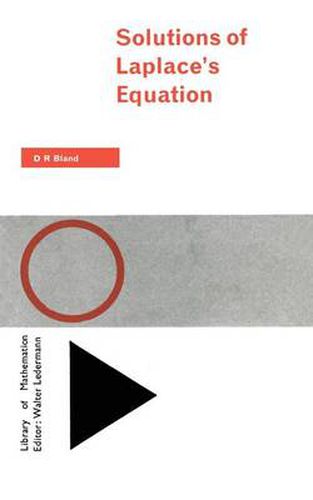Readings Newsletter
Become a Readings Member to make your shopping experience even easier.
Sign in or sign up for free!
You’re not far away from qualifying for FREE standard shipping within Australia
You’ve qualified for FREE standard shipping within Australia
The cart is loading…






This title is printed to order. This book may have been self-published. If so, we cannot guarantee the quality of the content. In the main most books will have gone through the editing process however some may not. We therefore suggest that you be aware of this before ordering this book. If in doubt check either the author or publisher’s details as we are unable to accept any returns unless they are faulty. Please contact us if you have any questions.
THIS book is an introduction both to Laplace’s equation and its solutions and to a general method of treating partial differential equations. Chapter 1 discusses vector fields and shows how Laplace’s equation arises for steady fields which are irrotational and solenoidal. In the second chapter the method of separation of variables is introduced and used to reduce each partial differential equation, Laplace’s equa tion in different co-ordinate systems, to three ordinary differential equations. Chapters 3 and 5 are concerned with the solutions of two of these ordinary differential equations, which lead to treatments of Bessel functions and Legendre polynomials. Chapters 4 and 6 show how such solutions are combined to solve particular problems. This general method of approach has been adopted because it can be applied to other scalar and vector fields arising in the physi cal sciences; special techniques applicable only to the solu tions of Laplace’s equation have been omitted. In particular generating functions have been relegated to exercises. After mastering the content of this book, the reader will have methods at his disposal to enable him to look for solutions of other partial differential equations. The author would like to thank Dr. W. Ledermann for his criticism of the first draft of this book. D. R. BLAND The University, Sussex. v Contents Preface page v 1. Occurrence and Derivation of Laplace’s Equation 1. Situations in which Laplace’s equation arises 1 2. Laplace’s equation in orthogonal curvilinear co-ordinates 8 3.
$9.00 standard shipping within Australia
FREE standard shipping within Australia for orders over $100.00
Express & International shipping calculated at checkout
This title is printed to order. This book may have been self-published. If so, we cannot guarantee the quality of the content. In the main most books will have gone through the editing process however some may not. We therefore suggest that you be aware of this before ordering this book. If in doubt check either the author or publisher’s details as we are unable to accept any returns unless they are faulty. Please contact us if you have any questions.
THIS book is an introduction both to Laplace’s equation and its solutions and to a general method of treating partial differential equations. Chapter 1 discusses vector fields and shows how Laplace’s equation arises for steady fields which are irrotational and solenoidal. In the second chapter the method of separation of variables is introduced and used to reduce each partial differential equation, Laplace’s equa tion in different co-ordinate systems, to three ordinary differential equations. Chapters 3 and 5 are concerned with the solutions of two of these ordinary differential equations, which lead to treatments of Bessel functions and Legendre polynomials. Chapters 4 and 6 show how such solutions are combined to solve particular problems. This general method of approach has been adopted because it can be applied to other scalar and vector fields arising in the physi cal sciences; special techniques applicable only to the solu tions of Laplace’s equation have been omitted. In particular generating functions have been relegated to exercises. After mastering the content of this book, the reader will have methods at his disposal to enable him to look for solutions of other partial differential equations. The author would like to thank Dr. W. Ledermann for his criticism of the first draft of this book. D. R. BLAND The University, Sussex. v Contents Preface page v 1. Occurrence and Derivation of Laplace’s Equation 1. Situations in which Laplace’s equation arises 1 2. Laplace’s equation in orthogonal curvilinear co-ordinates 8 3.